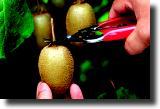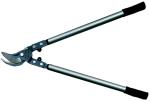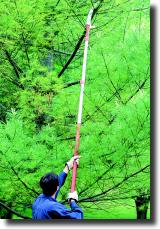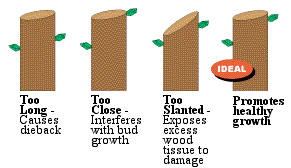
Why Should I Prune?
Pruning Basics
Key Points: |
Note:This tip sheet is for general guidance only. Contact your County Extension agent or land grant university for additional information on pruning techniques.
|
 Why prune?
Why prune?
There are many different reasons to prune or to remove selected parts of a plant. They could be to train or direct growth, control size and shape, improve health, increase landscape effect, improve growth for flowers and fruits, or for safety reasons.
When should you prune?
The best time to prune varies with each plant species. Plants that flower during the spring normally are pruned after they bloom. If you were to prune before bloom you would remove the flower buds. Summer blooming plants generally are pruned during the winter when they are dormant. Pruning should not be done in the late summer or fall because the re-growth makes them more susceptible to damage from the cold. If the plants are not being grown for their flowers, the best time to prune may be in the winter dormant period. Removing of dead, diseased or damaged branches should be done as soon as possible, no matter what time of year. Pruning should be done year-round as needed.
What are the right tools for pruning?
Picking the right tool for the job will mean less work for you and ensures that the plant will heal more quickly. The following is a list of different types of tools and what their uses are:
 Hand pruners are used for small jobs and cut up to ¾" in diameter. Pruners are
available with either bypass or anvil blades.(See what is an anvil and/or bypass pruner.)
Hand pruners are used for small jobs and cut up to ¾" in diameter. Pruners are
available with either bypass or anvil blades.(See what is an anvil and/or bypass pruner.)
 Loppers have longer handles, increasing your reach and leverage for those hard to cut
branches. Loppers are for larger jobs and can cut up to 2" in diameter.
Loppers have longer handles, increasing your reach and leverage for those hard to cut
branches. Loppers are for larger jobs and can cut up to 2" in diameter.

Hedge shears are ideal for nearly all hedges and shrubs, except for larger woody branches.
![]() Pruning saws help remove stems you cannot cut with hand pruners or lopping
shears.
Pruning saws help remove stems you cannot cut with hand pruners or lopping
shears.
 Pole pruners help reach high out-of-reach branches up to 2" in diameter. They are ideal where ladders would be inconvenient or would damage the tree. They consist of pruner blades mounted on long wooden or aluminum poles. A cord or chain is used to activate the spring-loaded blades.
Pole pruners help reach high out-of-reach branches up to 2" in diameter. They are ideal where ladders would be inconvenient or would damage the tree. They consist of pruner blades mounted on long wooden or aluminum poles. A cord or chain is used to activate the spring-loaded blades.
 Pole saws are a cross between pole pruners and pruning saws. They help to get at out-of-reach branches up to 3" in diameter.
Pole saws are a cross between pole pruners and pruning saws. They help to get at out-of-reach branches up to 3" in diameter.
What is an anvil and/or bypass pruner?
 Hand pruners and loppers are available with either bypass or anvil blades. Bypass blades are sharpened, curved,
and overlap, similar to scissor blades. Bypass blades are ideally used for new green growth. Anvil blades have a
straight upper blade that cuts against a broad, flat blade. Anvil blades are most efficient for dry, hard and
old growth.
Hand pruners and loppers are available with either bypass or anvil blades. Bypass blades are sharpened, curved,
and overlap, similar to scissor blades. Bypass blades are ideally used for new green growth. Anvil blades have a
straight upper blade that cuts against a broad, flat blade. Anvil blades are most efficient for dry, hard and
old growth.

What is the proper cut?
Proper cuts require good, sharp pruning equipment. Make all cuts clean and smooth and do not leave stubs or remove bark. In most cases, you should cut back each stem to a bud or branch. Do not make the cut too close or too far away because most new growth will come from this area. Select the branch to be pruned and cut it back to ½" above an outer bud or to the collar area of a branch about half the size of the main branch that connects a 45° angle. Your cuts should be slanted upward at about 45° to prevent water from collecting in the cut.

When cutting branches more than 1 ½" in diameter, use a three-part cut. Make the first cut from below about 6-12 inches out of the trunk. Make the second cut from above, about 3-9 inches down the branch, until the branch falls away. Then cut the remaining limb at a 45° angle so the bark collar remains intact.
Do's and Don'ts of Pruning
Do: |
Don't |
|
|